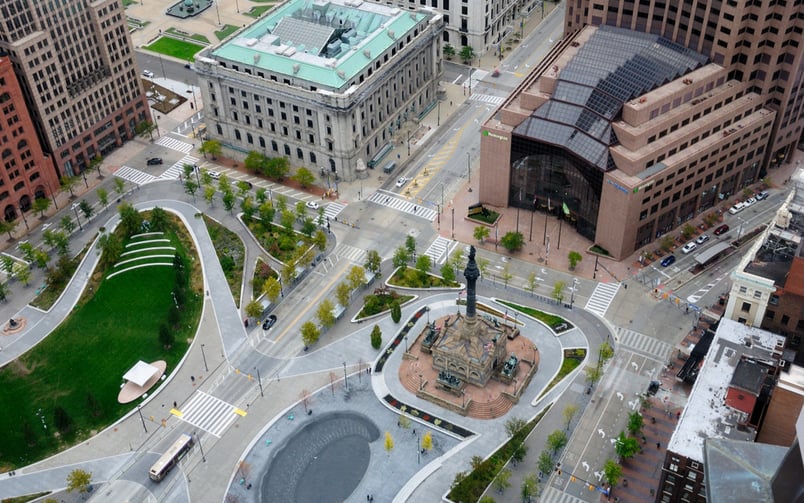There are many different factors that go into designing a successful public square. Having worked on some of the most fruitful public squares in the US, we are excited to share what we have learned over the years.
Public squares have long served as the hearts of cities and towns, a gathering place where people come together and enjoy the place they call home. It also attracts visitors from all over the world, showing them what culture in that city looks like.
Well-designed public squares have been proven to attract more business for local shops, boost community morale, and enhance public safety. For these reasons, and so many more, designing successful public squares is incredibly important.
How to Design Successful Public Squares
Put People First
A city square isn’t productive unless it is comfortable for people to hang out there. That means you need benches, maybe a few tables, shade and so forth. Adding chargers for cell phones and other devices is another popular trend because it speaks to what the modern person needs in their day-to-day life.
Flexibility is Key
Not only will the square change on a weekly basis, but it needs to be flexible enough to withstand the changes that will arise over the years.
One day the square may serve as a farmer’s market, the next day it might be a pop-up tennis match, and the following week it could serve as an open-air art market. The possibilities are endless as long as you keep the design of a public square flexible.
Consider adding portable furniture and adding storage for games, umbrellas, tables, and other things that can be set up on an as-needed basis. Another great idea is to incorporate a retractable or portable stage.
New Season, New Changes
With each new season comes a whirlwind of new possibilities. That’s why some of the world’s most popular squares, like Rockefeller Center and Bryant Park, have strategies in place to facilitate change based on the season. In winter a square may play host to an outdoor skating rink, while in the summer it turns into a horticulture or art display.
Easy Access, Please
No square will be successful if it is difficult to access. The most highly used squares are easy to get to by foot. Remember, pedestrian plazas are for pedestrians – not motorists and their vehicles.
Make sure there are well-marked cross walks, narrow streets in the surrounding area, and that any nearby traffic moves slowly and remains separated with physical barriers. If there is too much fast-moving traffic all around a plaza, chances are, pedestrians won’t flock to it and pedestrians are essential to a populated square.
The Inner & Outer Square Concept
Frederick Law Olmsted was a visionary park planner. Over 100 years after he brought his ideas to light, they remain relevant today. He created the concept of an “inner park” and an “outer park.” For instance, picture the outer park as a library or a collection of shops and coffee stands, while the inner park offers seating for people to sip their coffee and read their library books. This is an ideal use of the inner and outer square concept.
Oppositely, picture the outer square is a big 8-foot brick wall, and on the inside some tables and chairs to sit at. This is far less cozy, and that wall is going to make the square far less accessible and desirable.
For an inner square to be successful, the outer square must be equally inviting and full of activity.
Setting Up a Solid Plan for Maintenance
You could have the best city square in town but if maintenance starts to go downhill people may stop returning. That’s why it’s important to have a plan in place for maintenance before you ever even open the square to the public.
A good management team should know what it takes to keep the space in top-notch shape. Installing receptacles, using native plants that require little maintenance, and installing benches and planters that are resistant to graffiti are all good ways to reduce maintenance issues from the get-go.
Don’t Forget Greenery
Trees, flowers, and foliage of all types are encouraged at city squares. Greenery makes us happy and is especially necessary in big urban cities where concrete abounds. Nature is proven to boost morale and attract more people to an area.
Even if you are looking at a sea of concrete, there are still plenty of ways to add greenery through different sized planters. An oversize planter can be used to house a tree that shades a nearby bench, while smaller planters can play home to bushes and flowers.
Take Trust in TerraCast Products
Our products are featured in some of the busiest public squares in the US, including Times Square New York. That’s because everything from our planters to light posts are made right here in the USA using unmatched materials designed to long outlast the competition. Learn more or shop our complete collection here.

